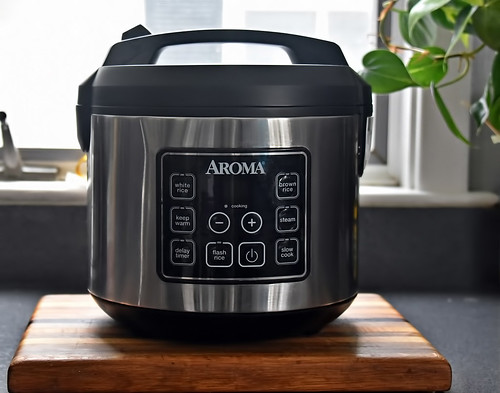Rice cooker and their principle
A Rice cooker is a kitchen appliance that was designed to boil rice. Let’ see the main principle of the cooker operation. The cooker has a main inner body part and it has an inner cooking container that gets in touch with rice, has a heat source, and thermostat.

The thermostat usually measures the temperature of the cooking bowl and controls the heat. When the bowl is filled with water and rice, it reaches the boiling point at 100⁰c,212⁰ F.
Why is the rice cooker boiling over?
Rice has a large amount of starch. When you start to heat your rice cooker in an electronic device, the heat inside the machine starts to increase the temperature and the water starts to boil inside the container.
When the boiled water mixes with the starch in the rice grains, it starts to create bubbles and those bubbles expand beyond the capacity of the cooker.
The bubbles appear to be large and foamy and it increases in size when it feels the rise in temperature and this is the reason for rice cooker boils over.
The first reason is due to excess water causes boils over. If you add more amount of water in the cooker it will cause trouble and your rice may come out overcooked. Another reason is over the rise in temperature causes the rice cooker boiling over.
Starch
Do you know that the rice cooker can boil over is due to rice? Using more amount of starch rice along also with boiled water causes boils over. The amount of starch within your rice which may differ based on the brand that you use.
You might think where will I find such kind of starch? Here we go. To use low starch level, most of the expensive brands wash their rice before packaging. If you use cheap prized rice instead of branded ones, it may result in starch related problems.
So now you know the reason because of the excess of starch on the rice, it causes boils over. Naturally, rice contains starch and it’s not easy to remove the excess amount of starch.
If you noticed a lot of starch in the cooker, turn your settings into low. If your rice cooker doesn’t have such a setting then unplug the cooker.
Now you know the reason the starch causes the rice cooker to boil over. If you might ask them how to use the starch and what kind of rice I should use to avoid boil over?
Let us see how to use low starch kinds of rice. You can find two types of starch in the rice. They are
- Amylose
- Amylopectin
Amylose will give you a bowl of perfectly separated grains of rice. When your rice has a lot of amyloses it gives a low glycemic index number. Long grain white rice has a vast amount of amylose. Starch always get dissolved into the water.
Amylopectin is high in short-grain rice, so it tends you to give a sticky and with this kind of rice, you can make rice pudding or risotto.
What kind of rice has high amylose and low amylopectin?
- Long grain white rice
- Basmati
- Jasmine
How to avoid the rice cooker from boiling over?
Wash the rice
The first step is to wash your rice before cooking and it will help in eliminating the other substances. By washing, starch gets washed off from the rice grains.

After this you can recognize while preparing cooked rice, it will give you a bowl of free and smooth rice.
Steps for washing the rice
- Take a large bowl that can hold a large volume of water. Transfer a required amount of rice to the bowl and add water to mix with the rice.
- After adding water to the rice. Use the water of your preference. Your water doesn’t have to be ice cold, it can be a bit cold.
- Add the water until it covers the rice fully. You can also try by pouring the water three times the amount the same as rice.
- Now wash your hands properly and move your rice with your hands. Apply light pressure to stir your rice.
- You can observe that excess starch on rice will come off.
- Begin to pour out the starchy water into a separate bowl or the sink. Block the rice from being poured out along with the starch water.
- You can punch your rice so the excess starch will be removed out.
- After this add more water into the bowl and repeat the same procedure until you see water coming out is clear.
- You can also soak your rice for 30 minutes by this process it allows the moisture time to soak in the grain. And gives your rice uniform finish.

